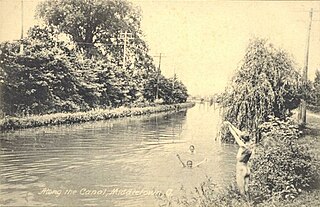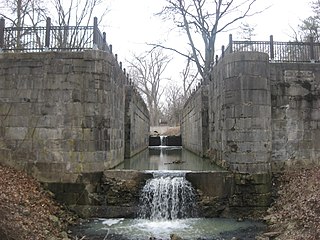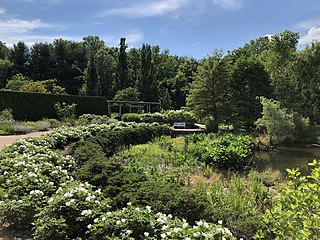
The Maumee River is a river running in the United States Midwest from northeastern Indiana into northwestern Ohio and Lake Erie. It is formed at the confluence of the St. Joseph and St. Marys rivers, where Fort Wayne, Indiana, has developed, and meanders northeastwardly for 137 miles (220 km) through an agricultural region of glacial moraines before flowing into the Maumee Bay of Lake Erie. The city of Toledo is located at the mouth of the Maumee. The Maumee was designated an Ohio State Scenic River on July 18, 1974. The Maumee watershed is Ohio’s breadbasket; it is two-thirds farmland, mostly corn and soybeans. It is the largest watershed of any of the rivers feeding the Great Lakes, and supplies five percent of Lake Erie’s water.

The Wabash and Erie Canal was a shipping canal that linked the Great Lakes to the Ohio River via an artificial waterway. The canal provided traders with access from the Great Lakes all the way to the Gulf of Mexico. Over 460 miles long, it was the longest canal ever built in North America.

The Miami and Erie Canal was a 274-mile (441 km) canal that ran from Cincinnati to Toledo, Ohio, creating a water route between the Ohio River and Lake Erie. Construction on the canal began in 1825 and was completed in 1845 at a cost to the state government of $8,062,680.07. At its peak, it included 19 aqueducts, three guard locks, 103 canal locks, multiple feeder canals, and a few man-made water reservoirs. The canal climbed 395 feet (120 m) above Lake Erie and 513 feet (156 m) above the Ohio River to reach a topographical peak called the Loramie Summit, which extended 19 miles (31 km) between New Bremen, Ohio to lock 1-S in Lockington, north of Piqua, Ohio. Boats up to 80 feet long were towed along the canal by mules, horses, or oxen walking on a prepared towpath along the bank, at a rate of four to five miles per hour.

The Chesapeake and Ohio Canal National Historical Park is located in the District of Columbia and the state of Maryland. The park was established in 1961 as a National Monument by President Dwight D. Eisenhower to preserve the neglected remains of the Chesapeake and Ohio Canal and many of its original structures. The canal and towpath trail extends along the Potomac River from Georgetown, Washington, D.C., to Cumberland, Maryland, a distance of 184.5 miles (296.9 km). In 2013, the path was designated as the first section of U.S. Bicycle Route 50.

The Ohio and Erie Canal was a canal constructed during the 1820s and early 1830s in Ohio. It connected Akron with the Cuyahoga River near its outlet on Lake Erie in Cleveland, and a few years later, with the Ohio River near Portsmouth. It also had connections to other canal systems in Pennsylvania.

The Blackstone Canal was a waterway linking Worcester, Massachusetts, to Providence, Rhode Island through the Blackstone Valley via a series of locks and canals during the early 19th century.

Metroparks Toledo, officially the Metropolitan Park District of the Toledo Area, is a public park district consisting of parks, nature preserves, a botanical garden, trail network and historic battlefield in Lucas County, Ohio.

Providence is a ghost town on the north side of the Maumee River in southern Providence Township, Lucas County, Ohio, United States, about 24 miles (39 km) southwest of Toledo. After suffering a destructive fire and a cholera epidemic in mid-19th century, the village was abandoned. In this period, canal traffic had also fallen off.
Peter Manor (1778–1847) was best known as the founder of the town of Providence, Ohio. Of French-Canadian descent, Manor was a fur trader in northwest Ohio starting in the late 18th century. Native Americans in the area, primarily Odawa, considered him a friend, which helped his business. He continued to trade with Native Americans and opened up a trading post that operated until approximately the early 19th century.

Wildwood Preserve Metropark is a nature reserve and historic estate located in Sylvania Township, Ohio. Wildwood is the most-visited of the 19-park Metroparks Toledo district.

Secor Metropark is a regional park in Richfield Township and Sylvania Township, Ohio, owned and managed by Metroparks Toledo. The park is in the Oak Openings Region.

Oak Openings Preserve Metropark is a nature preserve located in Swanton Township, Ohio, owned and operated by Metroparks Toledo. Most of the park is an oak savanna ecosystem, characterized by alternating wetland and vegetated dunes.
Bend View Metropark is a regional park located in Waterville, Ohio, owned and managed by Metroparks Toledo and named for its view of a 90-degree bend in the Maumee River.

Farnsworth Metropark is a regional park in Waterville, Ohio, owned and operated by Metroparks Toledo. The long narrow parks sits on the western shore of the Maumee River with a view of several islands, including Missionary, Butler and Indian islands, all of which are owned by the State of Ohio.

Blue Creek Metropark is a park and conservation area in Whitehouse and Waterville Township, Ohio, owned by Metroparks Toledo and partially leased to the city of Whitehouse.

Pearson Metropark is a regional park in Oregon, Ohio, owned and managed by Metroparks Toledo. It is one of the few remnants left of the Great Black Swamp. The park contains old-growth forest and wetlands. The park contains a pond with paddle boat rentals in the summer months and sledding in the winter months.

Side Cut Metropark is a regional park in Maumee, Ohio, owned and managed by Metroparks Toledo and named for being a sidecut on the Miami and Erie Canal.

Swan Creek Preserve Metropark is a regional park in Toledo, Ohio, owned and managed by Metroparks Toledo. The park contains several miles of often used trails.

Toledo Botanical Garden is a botanical garden in Toledo, Ohio, owned and managed by Metroparks Toledo.

Gaston's Mill-Lock No. 36, Sandy and Beaver Canal District, is a historic district listed in the National Register of Historic Places. The district is located within Beaver Creek State Park, approximately 1 mile south of Clarkson, Ohio. Gaston's Mill was constructed in 1837 and was powered by Little Beaver Creek. Lock 36 was one of 90 locks on the Sandy and Beaver Canal. Construction of this canal began in 1834 but was not completed until 1848.


















